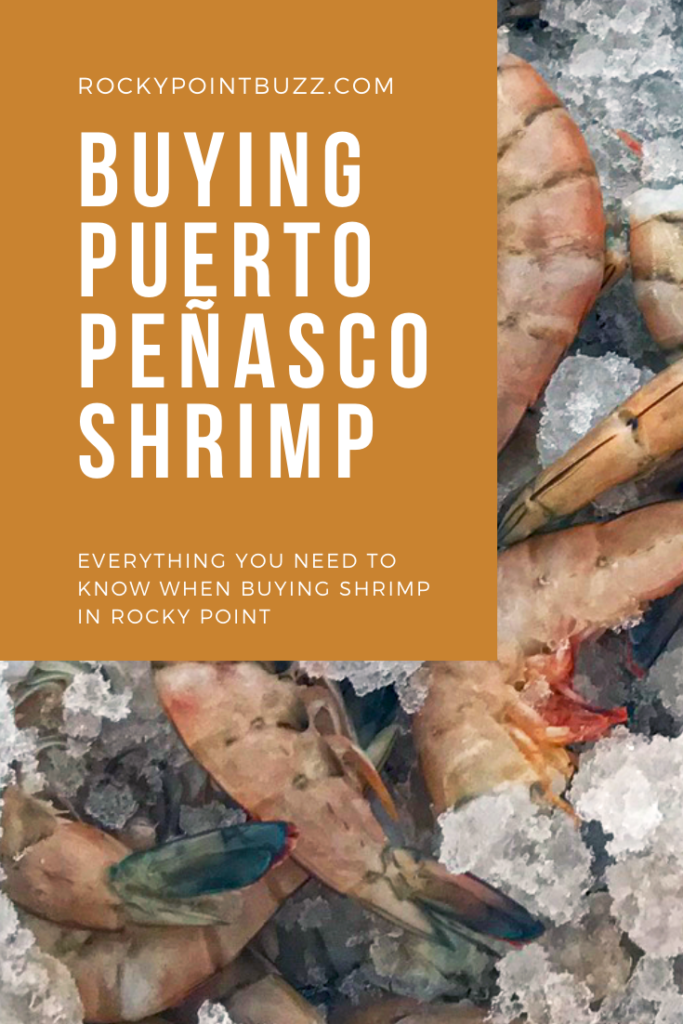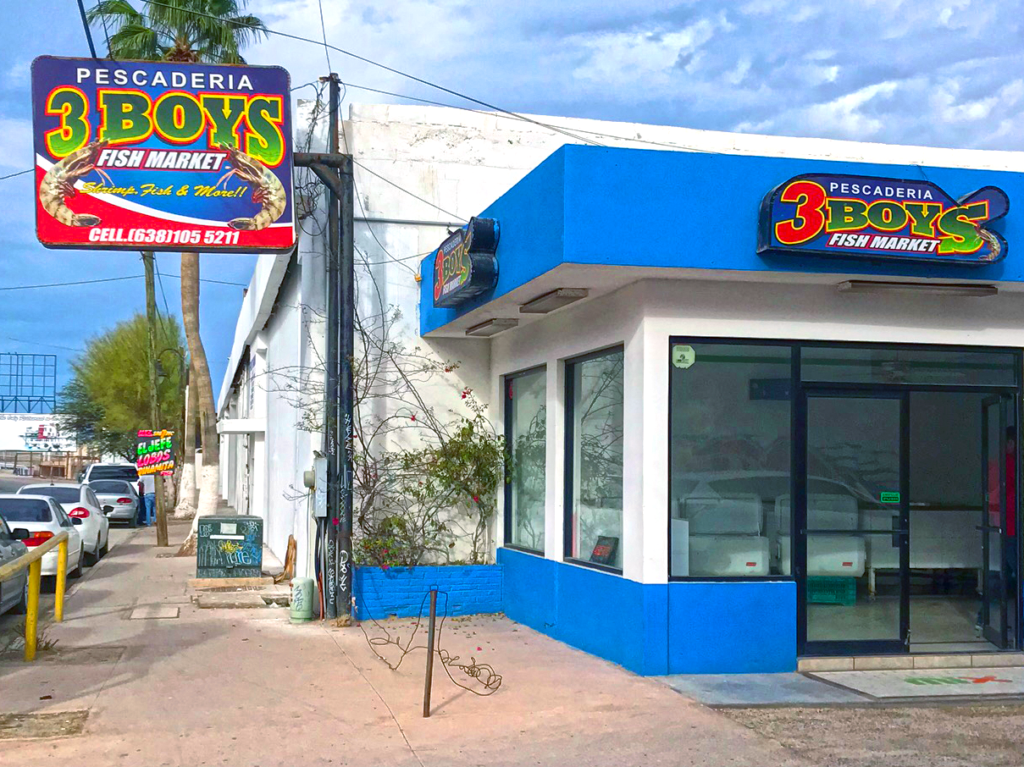
Buying shrimp from the venders in Puerto Peñasco can be confusing and intimidating. But because it is wild and fresh and not farmed, it’s worth knowing where to go, what to look for and how to buy it. We’ve been buying shrimp in Rocky Point for years. Let me answer some common questions so you too can pick up a few pounds on your next trip.
When buying shrimp in Rocky Point, you will need to know:
- Where to buy your shrimp
- How to know if it’s fresh
- How to order the right size and amount
- What you can expect to pay
- How to package it to bring it home
- Tips for bringing your shrimp back to the U.S.
In Puerto Peñasco, shrimp is an economic staple of this Sea of Cortez village. When it’s shrimp season, there isn’t a day you won’t see weathered and worn shrimp boats coming and going in and out of the old port. Every restaurant and road side taco stand usually serves up shrimp in one dish or another. And the streets of the fish market, El Malecón, are lined with fishermen looking to sell their catch.
Why Buy Shrimp in Rocky Point?
It’s wild. It’s fresh. And it helps the local economy.
Rocky Point Shrimp is Healthier than Store Bought Shrimp
It’s wild. It’s fresh. For shrimp lovers, fresh wild caught shrimp is far superior to the imported farmed shrimp you usually find at the local grocery store in the U.S. And because it’s fresh, you can buy it and eat it now or package it up and freeze it for later.
The Sea of Cortez, aka the Gulf of California, is unique in that it has a massive tidal range. The tide changes as much as 32 feet. This allows for the sea waters to get stirred up as deep as 1,500 feet, which creates strong current and upwellings that carry huge amounts of nutrients for shrimp to feed on.
By feeding on these natural nutrients, wild shrimp they have a more firm texture and are higher in protein and other healthy minerals and vitamins, like vitamin D and omega-3, when compared to farmed shrimp. And naturally they just taste better.
Shrimp contains high content of vitamin D, omega-3 fatty acids, selenium, B vitamins, zinc and phenylalanine.
The farmed shrimp that you buy in most stores in the U.S., on the other hand, are grown massive quantities in industrial tanks or man-made ponds, where they are fed commercial pellets and given antibiotics to survive in the man-made habitat. Farmed shrimp are also known to be contaminated with pesticides and other toxic chemicals from run off into the water sources.
The Local Economy
Shrimping is Mexico’s most important fish industry. The countries annual revenue for shrimping is about $260 million. In Puerto Peñasco, the shrimp industry creates around 800 direct jobs through the shrimp fleet and many more jobs through indirect businesses. Contributing to the local economy will help to keep Rocky Point going strong so we can continue to visit.
Is Rocky Point Shrimp Safe?
A reasonable question. Mexico is considered a developing country. We know the regulated standards are not the same as they are in the U.S. You may wondered about this when you see crates of unrefrigerated eggs for sale in the local grocery stores. Then there’s the age old stigma, “Don’t drink the water.” So why wouldn’t you ask if buying raw shrimp in Puerto Peñasco is a safe thing to do. Seafood or any raw meat can be hazardous to our health if it’s not handled properly.
As soon as the shrimp are brought on board the shrimp boat, they are flash frozen and placed in a freezer to stay fresh until they boat returns to port. This stops the shrimp from degrading, protecting the taste and texture. Once in port, the frozen shrimp can be sold directly from the shrimping boat companies store or is sold to the venders for resell.
Purchasing during shrimp season is the best way to ensure your shrimp is the freshest. Shrimp season runs from about mid-September to mid-March, give or take a few days. A good rule of thumb, “Any month with the letter R in it.” Buying shrimp outside of shrimp season might mean you don’t know how long ago your shrimp was caught.
Many repeat buyers will even tell you to wait until October or even December to buy the freshest catch. They say that September purchases could be the end of the previous seasons’ catch.
Another way to know if your shrimp is safe, the SMELL. If it smells to “fishy,” it’s probably starting to spoil. But a little shrimp smell, like the smell of cooked shrimp, is okay. Be aware of smells like gasoline or chlorine. These are signs of poor processing and storing.
Where to Buy Fresh Shrimp in Rocky Point
There are a lot of choices for where to buy the freshest shrimp in Rocky Point. For the past several years, we have gone to 3 Boys.

They have always been very friendly, reasonably priced and fair when buying shrimp. Their locations are pretty clean and they are set up to keep the temperatures cool. They carry large size shrimp. And I especially love that they would clean them and package them up into individual one pound packages for us for no extra charge. (More on that later.) We always recommend them to friends and family.
Fortunately today, if you don’t have a good recommendation from a friend who buys shrimp regularly, social media and review sites like Trip Advisor and Yelp can help you do decide.
When reading reviews, watch for things like freshness and fairness. While reviewers are always happy to share their negative experiences. Be sure to read the positives as well.
A good shrimp market review will include:
- Details about the freshness of the shrimp
- How the shrimp is kept ice cold to frozen
- The cleanliness of the location
- The friendliness of the staff
- The reasonableness of the price
- The fairness of the scales
Yes, some shrimp venders have been known to tip the scales in their favor. The only way to really be sure is bring your own scale to weigh before purchase. That said, if you think your package weight is grossly wrong, then walk out and pass on your purchase. If you think it might be close to accurate, consider re-weighing your purchase when you get back to your condo or hotel. If the vender severely shorted you, then don’t go back.
If you had a good experience, do other shrimp shoppers right and leave a review or spread the word. If you do leave a review, be sure to hit on all those items I listed above so future readers will have confidence in your review and help to keep your new favorite shrimp shop in business.
If you are still a little nervous about buying fresh shrimp from roadside venders, consider Pesquera y Procesadora. I haven’t had the chance to buy from there yet, but the reviews are all very good for shrimp and other seafood. They buy direct from the boats each morning. They say this is a good place to buy large quantities of shrimp and LARGE shrimp. Once I have a chance to check them out, I will update this article with my experience.
Choices When Buying Shrimp
Before you venture out to buy your shrimp, decide exactly what you want. This will make transaction go smoothly and communication easier if you don’t speak Spanish.
Think about how you will prepare your shrimp. Different recipes call for different sizes of shrimp. Also think about when you plan to prepare your shrimp. It can be kept frozen up to 5 months before it starts to deteriorate.
Shrimp Quantity and Weight Explained
Mexico uses the metric system, but vendors also deal in U.S. measurements. Shrimp is usually sold by the kilo, which is about 2.2 pounds.
You will want to be aware of weight so you can negotiate the cost of your shrimp purchase.
Shrimp Sizes
In the U.S., shrimp size is described in terms of the “count.” That is the number of shrimp you can expect in a 1 pound purchase. For example, if you buy one pound of 21/25, you will get 21 to 25 shrimp in the pound. If you buy one pound of 51/60, you are looking at 51 to 60 individual shrimp. When you get into the huge shrimp, you will see counts like U/10 or U/15. This means there are “under 10” or “under 15” individual shrimp in a pound.
| Shrimp Size | Count Per Pound | Avg Number of Shrimp |
|---|---|---|
| Small | 51/60 | 55 |
| Medium | 36/40 | 38 |
| Large | 31/35 | 33 |
| Jumbo | 21/25 | 18 |
| Colossal | U12 | 9 |
| Extra Colossal | U10 | 5 |
While the count may or may not be used in negotiating your shrimp with the fish market vendor, you will see these counts used in reviews and on forums when people talk about current prices.
Counts are also helpful for recipes. If you know what recipes you plan to make before buying your shrimp, you will know what size you are going to need to plan to buy.
Shrimp Type
The three most common shrimp coming out of the Sea of Cortez are white shrimp, brown shrimp and blue shrimp.
The most common of the three is white shrimp.
Brown shrimp are said to be the more flavorful. They are reddish to light brown with somewhat yellow legs. The can grow up to just over 6 inches long.
Puerto Peñasco is “famous” for the BIG blue shrimp. Blue shrimp can get as big as 10 to 11 inches long. Color wise, they are light blue to white.
Cost of Shrimp
The cost of shrimp in Rocky Point can vary and it can change depending on the success of the season. But we have had a pretty consistent rate for the past 5 years or so and many friends confirmed the same. To validate these prices a bit more, I spent some time researching many forums and the prices others say they are paying for shrimp.
You can expect to pay $5 to $7 per pound for medium size shrimp. I noticed when I went in mid-week by myself without my husband they charged me $5 per pound for medium browns. When we went back in on a busy weekend and with my husband, we were charged $7 per pound for the same shrimp and they were not interested in bartering.
We also buy alot of blue shrimp. They are considered Extra Large in size. We pay $8 per pound for these. This rate has been consistant for several years and among our friends who shop at 3 boys and with other shimp sellers.
Prepping Your Shrimp For Purchase
When buying shrimp, keep in mind that shrimp is frozen when as soon as it is sorted out of the nets. So unless you are buying directly from the boat, your shrimp will have likely been frozen and thawed so that the vender can separate the bulk and count out your purchase.
Depending on the shrimp seller, you may have some option with how your raw shrimp is prepared and packaged when you buy it.
For example, you can buy your shrimp in :
- Frozen Blocks: Whole shrimp purchased by weight
- Whole: Shell, tail and vein intact
- Cleaned Shell On: Deveined with shell and tail intact
- Cleaned Tail Only: Deveined with shell removed and tail intact
- Cleaned No Shell, No Tail: Deveined with shell removed and tail removed
You can even ask the shrimp shop to split up larger purchases into individual portion sizes. For example, when we buy ten pounds, we would have them put them into separate one pound bags. This way we could freeze them right away and only thaw what we needed later. When I’m cooking shrimp for two, I just thaw one pound. It’s really convenient.
Most shops will clean your shrimp at no extra charge, but we always tip extra for their time.
A couple of things to keep in mind before having the shells removed. Freezing shrimp with the shell will preserve the flavor and texture longer. So if you are not planning on using your shrimp right away, keeping the shell on is probably a good idea.
Next, if you do have your shrimp cleaned and shells removed, the vender will weigh your shrimp before they clean it, so your final weight will be less than what you paid for.
Bringing Your Shrimp Home
Bringing your shrimp back to the U.S. involves packaging it to withstand the trip and making sure your “imported” shrimp is ok to cross the border. There’s not really much to worry about here. Crossing the border with shrimp is easy. I think the most important consideration is keeping your shrimp cold and fresh on the travel home.
Packing Your Shrimp
If you know you are going to buy shrimp on your visit, be sure to pack a good quality ice chest to keep your shrimp frozen.
We use the RTIC Hardside 20 or the RTIC Insulated Soft Cooler. Both are perfect for 10 pounds of shrimp and still have room for some fresh fish and ice.
If your shrimp purchase is a last minute decision, you can find cheap foam coolers to get your shrimp home. Be sure to get a cooler large enough to a lot of ice. And buy your shrimp on your way out of town so your cheap cooler only has to do the job for the ride home.
If you can, double bag your shrimp. The shells and tails will poke holes in the bag and cause shrimp “juice” to leak or worse, allow melted ice water into your packages causing your shrimp to start breaking down.
One final note on packaging your shrimp. If you have the opportunity to freeze your shrimp immediately, do it. Take it back to your condo or house and get it into the freezer. Traveling with frozen shrimp is the best way to preserve it for the trip home. Especially when the weather temperature is high.
Crossing the Border with Shrimp
The most asked question about bringing shrimp into the U.S. from Mexico is “How much shrimp can I bring back from Mexico?” The self dubbed Rocky Point gurus are all over the place with their expertise on this question.
I’ve read 5 pounds per person; 45 pounds per vehicle; 55 pounds per vehicle and more.
Seems to me, the best way to get real answer is to go right to the gatekeepers.
Food importation is regulated by the FDA and wild caught fish, including shellfish, are also regulated by the U.S. Fish and Wildlife Service (FWS). Customs and Border Patrol (CPB) is authorized to enforce the FDA and FWS requirements.
I checked out all of these agencies and here is what I found.
US Government Authority: Food And Drug Administration
“Personal quantities of seafood not intended for commercial consumption are not subject to approval by the FDA. Most personal quantities of seafood are admissible, with the exception of endangered species which are subject to restrictions by the FWS.”
US Government Authority: Customs and Border Patrol
“The following are generally admissible: Fish – Personal amounts of fish, shrimp, abalone and other seafood are allowed and can be fresh, frozen, dried, smoked, canned or cooked.”
U.S. Government Authority: Fish and Wildlife Service
“…sport-caught fish or shellfish …taken for recreational purposes in Canada or Mexico are exempt from import declaration requirements unless the species involved is injurious, or requires a permit.”
Finally, all specifically say: You must declare your shrimp. Failure to do so could result in penalties and fines up to $10,000. So let the border agent know you bought some shrimp on your trip. We always let them know and we’ve never had any issues.
How Much Shrimp Can I Bring Back from Mexico?
What I DID NOT find in my search from the authorities is exactly how much shrimp you can bring back from Mexico. The only mention of quantity is “Personal quantities.” Who can say exactly how much that is?
The most “authoritative” resource I could find was a USA Today article that states, “You are allowed to bring 5 lbs. of shrimp per person into the United States, so shop accordingly.” But again, I found NOTHING on the government agency sites providing a specific amount.
That said, keep in mind that shrimp is only good for up to 5 months in the freezer. So bring back just enough to get you through to your next trip to Rocky Point.
So unless there is a current U.S. ban on bringing shrimp into the U.S., there are no restrictions for bringing shrimp for personal consumption back to the U.S. from Mexico.
Enjoying Fresh Shrimp From Puerto Peñasco
There are so many ways to enjoy your fresh Rocky Point shrimp.
My favorite is Shrimp Ceviche. (We use medium shrimp for ceviche.)
But shrimp can be prepared simply with some basic seasonings on a kabob or folded in a shrimp taco. (Those big blue shrimp are perfect for barbeque grilled shrimp.)
You just can’t go wrong with such fresh shrimp.

Enjoy!


